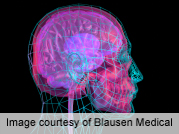
MONDAY, Aug. 13 (HealthDay News) — A condition known as leukoaraiosis alters brain function in older people, according to a small new study.
Contrary to past belief, researchers found this common condition, in which diseased blood vessels lead to small areas of damage in the brain, is not a harmless part of the aging process.
For people with leukoaraiosis, which is also called small vessel ischemia, MRI scans reveal the tiny areas in their brain that have been deprived of oxygen. These areas appear as bright white dots.
“There has been a lot of controversy over these commonly identified abnormalities on MRI scans and their clinical impact,” said Dr. Kirk Welker, an assistant professor of radiology in the College of Medicine at Mayo Clinic in Rochester, Minn. “In the past, leukoaraiosis has been considered a benign part of the aging process, like gray hair and wrinkles,” he added in a Radiological Society of North America news release.
These brain lesions are common among people older than 60 years of age. Some people, however, are affected more than others, the researchers noted.
“We know that aging is a risk factor for leukoaraiosis, and we suspect that high blood pressure may also play a role,” Welker said.
To test the effects of leukoaraiosis, older patients with normal brain function involved in the study underwent special MRI scans that measured metabolic changes in an active part of their brain. The researchers divided participants into two groups. One group included 18 participants who had a “moderate” 25 milliliters of leukoaraiosis. The other group included 18 other patients of the same age but who had less than a 5 milliliters of leukoaraiosis.
During the scans, participants were asked to identify word pairs and differentiate between straight and diagonal lines.
Although both groups successfully completed the tasks, the study showed the two groups had different brain-activation patterns. Patients with moderate levels of leukoaraiosis had abnormal activation patterns, including reduced activation in areas of the brain involved in language processing during the word task and increased activation in the visual-spatial areas of the brain during the diagonal-line task.
“Different systems of the brain respond differently to disease,” Welker explained. “White-matter damage affects connections within the brain’s language network, which leads to an overall reduction in network activity.”
The study authors concluded that preventing leukoaraiosis and identifying affected areas of the brain is key for patients undergoing pre-surgical brain-mapping or other treatments.
“Our results add to a growing body of evidence that this is a disease we need to pay attention to,” he said. “Leukoaraiosis is not a benign manifestation of aging but an important pathologic condition that alters brain function.”
The study was published online Aug. 13 in Radiology.
More information
Visit the U.S. National Institute of Neurological Disorders and Stroke to learn more about the brain and how it works.

